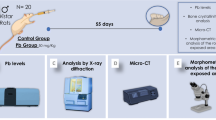Abstract
The use of hair and bone as media in evaluation of lead exposure was investigated in this study. For 12–16 wk rats were given tap water containing lead acetate in the following concentrations: 41.7 mg Pb/L, 83.3 mg Pb/L, and 166.6 mg Pb/L. The animals were sacrificed every 4 wk and their tibia bones and hair were collected for determination of lead content. In control animals, the lead level amounted to 1.2 μg/g (range 0.8–1.3 μg/g) and 0.7 μg/g (range 0.4–2.0 μg/g) in bone and hair, respectively. In the treated rats the accumulation of lead in bone and hair occurred in a dose-dependent manner. A positive corelation (r=0.876) was established between the lead levels in bone and hair of the rats. The regression equation was as follows: μg Pb/g bone=0.842×μg Pb/g hair+1.868. After discontinuation of exposure, a significant decrease in the lead content in bone and hair was noticed. About 9 wk after cessation of treatment, the lead content in hair declined to the pre-exposure level, but 64% of the maximal lead concentration did remain in bone. The results of this study indicate that during a continuous exposure the lead level in hair reflects its content in bone. Such phenomena did not occur during the postexposure period.
Similar content being viewed by others
References
H. Hu, F. L. Milder, and D. E. Burger,Environ. Health Perspect. 94, 107–110 (1991).
H. Hu, L. Pepper, and R. Goldman,Am. J. Ind. Med. 20, 723–735 (1991).
R. K. Sokas, A. Besarab, M. A. McDiarmid, J. M. Shapiro, and P. Bloch,Arch. Environ. Health 45, 268–272 (1990).
J. Erkila, R. Armstrong, V. Riihimaki, D. R. Chettle, A. Paakari, M. Scott, L. Somervaille, J. Starck, B. Kock, and A. Aitio,Brit. J. Ind. Med. 49, 631–644 (1992).
D. R. Chettle, M. C. Scott, and L. J. Somervaille,Environ. Health Perspect. 91, 49–55 (1991).
A. C. Todd, F. E. McNeill, and B. A. Fowler,Environ. Res. 59, 326–335 (1992).
U. Nilsson, R. Attewell, J. O. Christoffersson, A. Schutz, L. Ahlgren, S. Skerfving, and S. Mattsson,Pharmacol. Toxicol. 68, 477–484 (1991).
J. Skorowska-Zieleniewska, H. Symonowicz, and P. Marszał,Roczn. PZH. 34, 175–179 (1983).
J. Skorowska-Zieleniewska, B. Cabalska, B. Gołabek, H. Symonowicz, and M. Nowakowska,Roczn. PZH. 35, 337–340 (1984).
P. N. Ljubczenko, B. A. Revich, and W. W. Koleonik,Gig. Trud. Prof. Zabol. 3, 7–9 (1989).
W. Zaborowska, J. Wiercińska, and H. Maciejewska-Korak,Med. Pracy. 40, 38–43 (1989).
M. Wilhelm and F. K. Ohnesorge,Sci. Total Environ. 92, 199–206 (1990).
B. A. Revich,Gig. Sanit. 3, 55–59 (1990).
M. Schumacher, J. L. Domingo, J. M. Llobert, and J. Corbella,Sci. Total Environ. 15, 167–173 (1991).
A. Sukumar and R. Subramanian,Sci. Total Environ. 114, 161–168 (1992).
M. Wilhelm, D. Hafner, I. Lombeck, and F. K. Ohnesorge,Sci. Total Environ. 103, 199–207 (1991).
M. Leonsinidis and X. Kondaksis,Sci. Total Environ. 95, 149–156 (1990).
J. L. Burguera, M. Burguera, C. E. Rondon, C. Rivas, J. A. Burguera, and O. M. Alarcon,J. Trace Elem. Electrolytes Health Dis. 1, 21–26 (1987).
C. A. Bache, D. J. Lisk, J. M. Scarlett, and L. G. Varbone,J. Toxicol. Environ. Health 34, 423–431 (1991).
Z. Jaworowski and J. Bilkiewicz,Post. Fiz. Med. 1/2, 31–38 (1970).
T. W. Clarkson, L. Friberg, G. F. Nordberg, and P. R. Sager,Biological Monitoring of Toxic Metals, Plenum, New York, 1988.
A. Chatt and S. A. Katz,Hair Analysis, VCH, New York, 1988.
J. O. Christoffersson, A. Schuts, S. Skerfving, L. Ahlgren, and S. Mattson,Arch. Environ. Health 41, 312–318 (1987).
S. Skerfving, L. Ahlgren, J. O. Christoffersson, B. Haeger-Aronsen, S. Mattsson, and A. Schutz,Arch. Hig. Rada Toksikol. 34, 277–286 (1983).
W. Bolanowska, J. Piotrowski, and B. Trojanowska,Med. Pracy 18, 29–41 (1967).
P. Grandjean,Human Toxicol. 3, 223–228 (1984).
Author information
Authors and Affiliations
Rights and permissions
About this article
Cite this article
Hać, E., Krechniak, J. Lead levels in bone and hair of rats treated with lead acetate. Biol Trace Elem Res 52, 293–301 (1996). https://doi.org/10.1007/BF02789170
Received:
Accepted:
Issue Date:
DOI: https://doi.org/10.1007/BF02789170



